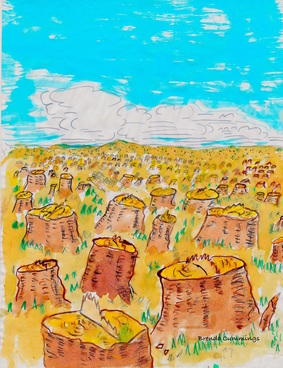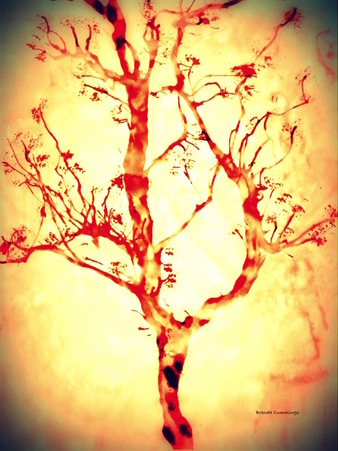
Basking Ridge, New Jersey is home to the oldest white oak tree in the country, and it is dying. It’s not dying from neglect. The tree, sometimes referred to as “Holy Oak”, has been loved, cared for and revered since farmers first built a church beside it in 1717 when it was already nearly 300 years old. The town has protected the tree ever since, and even in times of drought, citizens make sure that Holy Oak’s thirst is quenched. No one knows why the tree is dying, but at more than 600 years old, she has had a long, magnificent life.
The Reverend Dennis Jones, who is the present pastor of the Basking Ridge Presbyterian Church and a township native, said “Our oak tree is something we’re all very proud of and we take the stewardship of that tree very seriously.”
It’s unfortunate that humanity as a whole has not taken the stewardship of our planet’s forests as seriously.
The World Wildlife Fund (WWF) estimates that about 36 football fields worth of trees are lost every minute. 90 percent of the continental United State’s indigenous forest has disappeared since 1600. A major factor in global climate change, deforestation also causes countless other kinds of complications. Several diseases, for example, are believed to have spread to humans because of habitat destruction. With loss of habitat, animals are forced to move closer to humans who have little or no immunity to previously isolated diseases. Deforestation can set off devastating chains of events that often have global reach.
The causes of deforestation are many, and all of them are about us. Causes include land clearing for agriculture and cattle ranching, housing and urbanization, logging for paper, furniture and homes, mining, tree harvesting for consumer items like oil from palm trees as well as forest fires. Forest fires are becoming more frequent as climate change toys with weather patterns, and a vicious cycle is set in motion.
Even the water cycle is affected by deforestation because trees absorb rain water, releasing water vapor into the atmosphere. Deforestation causes species extinction, soil erosion, flooding, water pollution, climate imbalance and increased global warming.
Clearly, the solution to the problem is to plant more trees. We can also ban clear cutting and control the felling of trees, but reforestation is the bigger solution. Reforestation restores ecosystems and reduces the buildup of carbon dioxide in the atmosphere if, and when, enough trees are planted. There are several initiatives under way, and many organizations are trying to plant as many trees as possible, but it has so far been impossible to keep up with the numbers of trees that are already lost. What we need is divine intervention.
Enter former NASA engineer, Lauren Fletcher and his company, BIOCARBON ENGINEERING. This company is fighting deforestation by planting trees with UAV (unmanned aerial vehicles) or drone seed planting technology. They work with ecosystem restoration groups as well as industrial interests, and they aim to plant 36,000 trees a day or 1 billion trees per year. Company leaders say that industrial scale deforestation requires industrial scale reforestation. “Our technology is making it easier … to plant the trees, where they need them, at a fraction of the time and cost”, says Fletcher.
Holy Oak has offspring scattered all over New Jersey from a time about 10 years ago when her acorns were collected and grown at a local college. People who bought the saplings took them home and planted them. They are between 5 and 10 feet tall now, and when Holy Oak’s days are over, her offspring are ready to take her place.
Now our planet’s forests need replacing. In what many of us would have once described as a science fiction world, it may very well take drone technology to bring us back from the precipice. In the meantime, I love the story of Holy Oak, and I hope that all of us learn to revere our trees as much as she has been revered over the years.
The Reverend Dennis Jones, who is the present pastor of the Basking Ridge Presbyterian Church and a township native, said “Our oak tree is something we’re all very proud of and we take the stewardship of that tree very seriously.”
It’s unfortunate that humanity as a whole has not taken the stewardship of our planet’s forests as seriously.
The World Wildlife Fund (WWF) estimates that about 36 football fields worth of trees are lost every minute. 90 percent of the continental United State’s indigenous forest has disappeared since 1600. A major factor in global climate change, deforestation also causes countless other kinds of complications. Several diseases, for example, are believed to have spread to humans because of habitat destruction. With loss of habitat, animals are forced to move closer to humans who have little or no immunity to previously isolated diseases. Deforestation can set off devastating chains of events that often have global reach.
The causes of deforestation are many, and all of them are about us. Causes include land clearing for agriculture and cattle ranching, housing and urbanization, logging for paper, furniture and homes, mining, tree harvesting for consumer items like oil from palm trees as well as forest fires. Forest fires are becoming more frequent as climate change toys with weather patterns, and a vicious cycle is set in motion.
Even the water cycle is affected by deforestation because trees absorb rain water, releasing water vapor into the atmosphere. Deforestation causes species extinction, soil erosion, flooding, water pollution, climate imbalance and increased global warming.
Clearly, the solution to the problem is to plant more trees. We can also ban clear cutting and control the felling of trees, but reforestation is the bigger solution. Reforestation restores ecosystems and reduces the buildup of carbon dioxide in the atmosphere if, and when, enough trees are planted. There are several initiatives under way, and many organizations are trying to plant as many trees as possible, but it has so far been impossible to keep up with the numbers of trees that are already lost. What we need is divine intervention.
Enter former NASA engineer, Lauren Fletcher and his company, BIOCARBON ENGINEERING. This company is fighting deforestation by planting trees with UAV (unmanned aerial vehicles) or drone seed planting technology. They work with ecosystem restoration groups as well as industrial interests, and they aim to plant 36,000 trees a day or 1 billion trees per year. Company leaders say that industrial scale deforestation requires industrial scale reforestation. “Our technology is making it easier … to plant the trees, where they need them, at a fraction of the time and cost”, says Fletcher.
Holy Oak has offspring scattered all over New Jersey from a time about 10 years ago when her acorns were collected and grown at a local college. People who bought the saplings took them home and planted them. They are between 5 and 10 feet tall now, and when Holy Oak’s days are over, her offspring are ready to take her place.
Now our planet’s forests need replacing. In what many of us would have once described as a science fiction world, it may very well take drone technology to bring us back from the precipice. In the meantime, I love the story of Holy Oak, and I hope that all of us learn to revere our trees as much as she has been revered over the years.



 RSS Feed
RSS Feed
